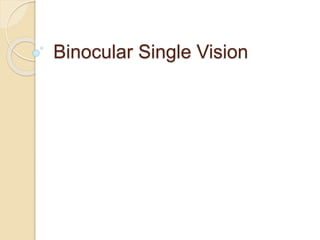
BSV.pptx
- 2. Binocular Single Vision Binocular single vision is the state of simultaneous vision with the two seeing eyes and blending of the separate images seen by each eye into one composite image.
- 3. Requirements for BSV Overlapping of visual field Approximately same image quality and size in both of the eyes Intact retinal neural system Accurate neuromuscular development and coordination so that visual axes are directed at the same object
- 4. Normal visual pathways Corresponding retinal areas (so that eyes are cyclopean.) Partial decussation of the optic nerves at optic chiasma to bring the retinal information from corresponding areas of each eye together at the visual cortex
- 5. Advantages of Binocular vision: 1. Second eye could be a safety factor against injury or disease 2. Two eyes may be used to achieve the wider field of view 3. Where the field of the two eyes overlap ,there is an advantage *In detection of faint images *Rejection of optical distortions. 4. Stereopsis – the most precise kind of depth perception 5. Summation of visual acuity (improved VA with both eyes open)
- 6. Visual Direction The projection of a given retinal element in a specific direction in subjective space. It is the line of sight. Principal visual direction is the direction in external space interpreted as the line of sight. This is normally the visual direction of fovea and is associated with a sense of direct viewing. Secondary visual directions are the projecting directions of extrafoveal points with respect to the principal direction of the fovea, associated with indirect viewing.) Projection Is the subjective interpretation of the position of an object in space on the basis of stimulated retinal elements. The localization of an object in space.
- 7. Corresponding points; Corresponding points are areas on retina that share the same subjective visual direction. Fovea of both eyes are corresponding points. Points on nasal retina of one eye have a correspondance with the temporal retina of other eye. The image of an object in the peripheral visual field falls on the extrafoveal element. To establish fixation on that object an eye movement of accurate amplitude is required. Each extrafoveal retinal element, therefore has a retinomotor value proportional to its distance from fovea.
- 10. The fovea normally has a retinal motor value of zero. A relationship exists between the cells in the retina of each eye. In order to understand this relationship, we arbitrarily assign retino-motor values to retinal areas. These areas or elements in each eye that share a same subjective visual direction (eg. +1 nasal RE, +1 temporal LE) are corresponding retinal points F +1 -1 F +1 -1
- 11. Abnormal retinal correspondance; It is a condition in which non- corresponding retinal points acquire a common visual direction. The fovea of fixating eye is paired with the non foveal element of the deviated eye. ARC allows limited amount of binocular vision.
- 12. Horopter it is an imaginary plane in space, all points on which stimulate corresponding retinal elements and therefore are seen singly.
- 14. Pannum’s Fusional Area It is a zone in front of and behind the horopter in which subjects not accurately stimulate corresponding retinal points. Objects are seen singly and stereoscopically. Physiological Diplopia Objects outside Pannum’s fusional area appear double.
- 16. Simultaneous Perception Grade I: Simultaneous perception occurs when the visual cortex perceives separate stimuli of the two eyes at the same time.
- 17. Fusion Grade II: It represents true fusion with some amplitude. It is the ability of producing a composite picture of two similar objects.
- 18. Stereopsis Grade III; perception of relative depth of objects, three dimensional. It arises when objects are behind and in front of the point of fixation but within the Pannum’s fusional area stimulate horizontally disparate retinal points simultaneously. It results in sensation of solid objects. It is measured in seconds of arc.
- 19. Abnormalities of BSV Confusion Is the simultaneous appreciation of two superimposed but dissimilar images caused by stimulation of corresponding retinal points by images of different objects. As the eyes are misaligned dissimilar image fall on corresponding retinal points causing visual confusion.
- 20. Pathological Diplopia; Pathological diplopia is the simultaneous appreciation of two images of the same object. It results from image of same object falling on non corresponding points.